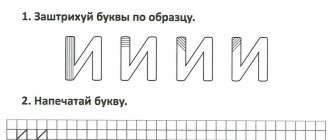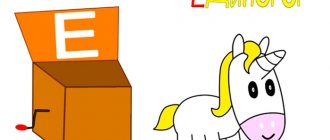Purpose of the lesson: we study the letter F, the formation of reading skills, the development of speech skills, the improvement of phonemic awareness, the basics of elementary graphic skills.
Tasks:
- introduce the preschooler to the letter F and the correct pronunciation of the sound;
- teach how to write the letter F in squares;
- to generate interest in learning poems and riddles.
Name what is shown in the pictures below:
Violet
Flamingo
Flag
Owl
When we pronounce the sound [f], the lower lip is pulled towards the upper teeth, there is only a narrow gap between the lower lip and the teeth. Say: FFF. The teeth and lower lip prevent air from leaving the mouth freely when we pronounce the sound [f].
- What sound is in the word FLAG, and in the word CLOSET, and in the word SHOES?
- At the beginning, at the end or in the middle of a word is the [f] sound in the word FLAG? - CLOSET? - SHOES? - APRON? — GRAPEFRUIT?
- Vowel or consonant sound [f]?
- Is this sound voiced or dull?
- Why?
- What other voiceless consonant sounds do you know?
- What voiced consonant sounds do you know?
Assignment: Printed letter F for preschoolers
Examine the letter F. Sew the letter F in the air and once in the notebook, carefully in the cells with a simple pencil or ballpoint pen.
In cases where the child is asked to write a whole line of a letter, syllable or word, the adult gives a writing sample at the beginning of the line. If a preschooler has difficulties, then an adult can draw two approximate lines, or put reference points that the child will connect with lines, or write the entire letters, and the child will simply circle them in a different color. Calligraphy should not be required at this stage of training.
Print
Target.
Clarify the articulation of sounds [f—f']; teach children to differentiate the sounds [f-v], [f' - v'] in words; teach children to select several nouns for one adjective; practice making sentences from given words; consolidate the ability to divide a word into syllables; determine the sequence of sounds in a word; familiarize children with the image of the letter Ff; consolidate the images of letters.
Equipment.
Mirrors, diagram for articulation analysis, panels of letters, chalk, board, sheet of blue paper, stamps, white gouache; sound houses; a picture (toy) with the image of a hedgehog; scissors and cut out letters according to the number of children.
Progress of the lesson
I. 1. - We met the wolf and the crow. What song did the wolf compose for the crow? (Multiple answers)
Analysis of the word crow:
divided into syllables; identify the first sound in a word and characterize it.
- What can you call a wolf's song? (Howl)
Sound analysis of the word howl
using sound houses: sequential determination of the first, second and third sounds with characteristics; name how many sounds there are in a word.
II. —Who did you help escape from the wolf in the last lesson? (To the hedgehog) Today a grateful hedgehog came to visit us (demonstration of a picture or toy). He wants to talk about himself.
The hedgehog's name is Fedya. He lives in the forest. Fedya finds something tasty and puffs with pleasure. Like this: f-f-f-f .
(Children repeat after the teacher) And if Fedya meets a fox or a wolf, he immediately curls up into a ball and snorts:
f-f-f-f .
(Children repeat)
Articulation of sounds.
— The hedgehog reminded us of the sounds [f-f']. When we pronounce them, the lower lip is slightly pressed against the upper teeth; the upper lip is slightly raised; tongue below; air passes through a narrow gap; the vocal cords vibrate.
Characteristics of sounds.
The sounds [f-f'] are consonants, there are hard and soft.
III. The teacher continues the story. As the story progresses, he displays pictures (these words are highlighted in the text).
Every night Fedya the hedgehog met with his friend Filya the eagle owl.
The eagle owl loved to sit on the bottom
branch
of a large
tree.
And the hedgehog sat down under a tree in
the grass.
They talked, looked at
the stars
and inhaled the delicate aroma of night
violets.
Then the eagle owl flew off to hunt.
And Fedya the hedgehog ran to the village. There, in one house, food was left for him. Today he found meatballs and fruit on a saucer.
The door to the house was slightly open.
And the curious Fedya looked through the crack. There, on the table, he saw a TV, a vase
of flowers,
markers, and
a socket with
halva.
The halva smelled so delicious. But she stood so high. Fedya sighed and ran home.
The teacher asks to name what is shown in the pictures on display and put them into two piles: words with sounds [f—f'] in one, words with sounds [v—v'] in the other.
The stack of pictures with the sounds [v-v'] is removed. Children are asked to identify words with hard and soft sounds {f-f'].
Sound [f]: fruits, markers.
Sound [f']:
eagle owl, violet.
3 .
Working with proposals.
The teacher asks the children to make sentences from the given words.
a) Eagle owl, sleep, day. (The owl sleeps during the day)
How many words are there in a sentence? What is the first word (second, third)?
b) Fedya, sniff, violet, (Fedya sniffs the violet)
Similar work.
c) Boy, draw, markers. (The boy draws with felt-tip pens)
Similar work.
IV. 1. Introducing the letter Ff.
- Today we learned a lot of words with sounds [f-f']. There are two sounds, but the letter that represents them is one.
The teacher shows the letter and places it on the panel of letters at the address: second floor (second row from the bottom), apartment No. 2 (second cell from the left).
2. Analytical and synthetic activity (using scissors and a letter constructor).
V. 1. Development of fine motor skills. Working with stamps.
Game "Snowfall". A sheet of blue paper is laid out on the table, jars of white gouache and several snowflake stamps are placed.
The teacher names an adjective, and the children select as many nouns as possible for it. Correct approval gives the right to make an imprint of a snowflake on a sheet of paper.
An approximate set of adjectives:
· February
(day, snow, frost, evening, wind, holiday, etc.);
· coffee
(service, smell, color, scarf, drink, etc.);
· violet
(pencil, tie, suit, etc.).
Attention! The game “Snowfall” can be continued after class.
Tale about the letter F
Magician Fedya
A huge plywood poster appeared in the forest, on which it was written:
“Hurry to see! The pheasant magician uses a magic lantern to transform a ficus into a violet! A fountain from an empty bottle! Instant photography without a camera!
“Hey,” said Fedya the owl, “everyone can do it with a magic lantern.” But I’ll show you the same tricks without a flashlight. Who has a ficus? “I have it,” said the bear and brought a ficus in a pot. - Put it on the stump and give me your apron here!
Fedya covered the ficus with an apron and whispered loudly:
- Fabes, mabes, stick, ficus, become a violet! - then as soon as the apron is pulled off, the ficus crashes to the ground! The pot is in pieces, the ficus is in half. - Do you know what I’ll do to you for this trick? - the bear roared. - Learn first, and then show tricks, half-educated fakir!..
(G. Yudin)
Speech therapy lesson “Sounds [F]-[F`]”
Topic: Sounds [F]-[F`]. Letter F.
Target:
creating conditions for familiarization with the sounds [F]-[F`],
letter F.
Tasks:
- Reinforce the correct pronunciation of sounds [f, f'].
- Practice identifying the sounds [f, f'] against the background of the word.
- Develop phonemic perception: the ability to identify sounds [f, f'] in a series of sounds, syllables, words.
- Strengthen the ability to determine the place of sound in a word.
- Develop the skills of sound and syllabic analysis and synthesis.
- Form ideas about related words.
- Introduce the letter F.
- Practice writing the letter F.
Material:
- Two dolls: Foma and Filya.
- Pictures depicting a camera, photographer, photo album, photographs.
- Pictures depicting objects whose names contain the sounds [f, f'].
- Sound lines.
- Pictures with the image of the letter F, eagle owl, key.
- Checked notebooks. Simple pencils.
Progress of the lesson:
1. Organizing time
Speech therapist:
Guys, two friends came to visit us: Foma and Filya. They brought a camera with them. What do you call a person who takes photographs? What does the photographer photograph with? What does a photographer get when he takes photographs? Where can I insert photos? What is the name of the photo album? Where does the photographer work? (Children's answers.)
2. Work on related words
Speech therapist:
Guys, which part is the same, common in the words photographer, camera, photo album, photograph? (Children's answers.) Yes, this part is “photo”. If you add other words to this word, you get new words.
These words are called “related”. They have one common part (photo), like a tree's root. These words form one family, which is why they are called cognates.
3. Isolation of the first sound in words, characteristics of sounds
Speech therapist:
Now I’ll say these words again, and you tell me what the first sound is in these words (photographer, photography, photo album, photo studio).
What is the sound [f]? (Firm, agreeable.)
In the word Phil, the first sound is ... (f). Tell us about the sound [f']. (Soft, consonant.)
Are the sounds [f, f'] voiced or unvoiced? (Deaf.) Explain why these sounds are deaf?
4. Subject message
Speech therapist:
Today we will listen and pronounce the sounds [f, f'].
5. Sound differentiation
[
f, f'
]
by ear
Speech therapist
: Now I will make sounds. And you, if you hear a hard sound [f] - raise the blue circle, and if you hear a soft sound [f'] - raise the green circle.
The speech therapist pronounces sounds (f, f, f, f, f, f, f...), and the children raise the corresponding mugs.
6. Differentiation of sounds by hearing
[
f, f'
]
in a series of syllables
Children are asked to stand on the carpet.
Speech therapist
: Guys, I will name the syllables. If you hear the sound [f] in a word, clap your hands, and if you hear the sound [f'], jump.
The speech therapist names the syllables (fa, fy, fi, fo, fyo, fya, fe, fe...).
7. Differentiation of sounds by hearing
[
f, f'
]
in a series of words
Speech therapist:
And now I will pronounce the words. If you hear the sound [f] in a word, clap your hands, and if you hear the sound [f'], jump.
The speech therapist names words (football, eagle owl, Africa, shoes, scarf, coffee...).
8. Game exercise “Find the right photo”
Speech therapist
: Foma and Filya took photographs. But they got confused. They argue about whose photo is. Let's help them, find the authors of the photos.
The photographs taken by Foma depict objects whose names contain the hard sound [f], and the photographs taken by Filya depict objects whose names contain the sound [f'].
The speech therapist lays out the “photos”, and the children take turns taking the pictures, determining the presence of the sounds [f, f'] in them and giving them to Phil or Foma.
9. Physical exercise
Speech therapist:
Filya and Foma, when they relax, like to do the following exercises:
And now everything is in order. Let’s get together and do some exercise.
Arms to the sides, bent, raised up, waved.
They hid them behind their backs and looked back over their right shoulder and over their left. They sat down together and touched their heels.
We stood up on our tiptoes and lowered our hands down.
10. Determining the location of sounds
[
f, f'
]
in the word
Speech therapist:
And now your friends are asking you to help them find out where in the words they really like the sounds [f, f'] are located - at the beginning, in the middle or at the end of the word. For example, Phil really likes the word “flag”. The F sound in this word is at the beginning. Now Filya and Foma will tell you words, and you will determine where the sounds [f, f'] are located - at the beginning, in the middle or at the end of the word.
(Children complete the task using special sound lines.)
11. Game exercise to develop syllabic synthesis
Speech therapist:
Our guests thank you for your help and offer to play a game that they love and play often.
I will throw the ball and name two sounds. And you will catch the ball and make syllables from these sounds.
The speech therapist throws the ball, naming a couple of sounds, and the children make up syllables (f...a - fa, f...i - fi, o...f - of, etc.)
Then the speech therapist suggests coming up with words with these syllables: Filya and Foma tried to find words with these syllables, but, unfortunately, they did not succeed. Guys, please help them, name the words with the syllables you just made.
(Children name the words: veil, photograph, ficus, cap...)
12. Introducing the letter F
Speech therapist
: Today we listened and pronounced sounds [f, f]. These sounds are denoted by the letter F. The speech therapist shows a picture of the letter F.
Speech therapist
: What does the letter F look like?
(Children answer.)
After the children express their opinion, the speech therapist shows symbol pictures and reads poetry:
- Eagle owl, two huge eyes, will immediately remind you of the letter F.
– Everyone knows without prompting: The letter F is like the key to a fairy tale.
Karabas will never take it away from us.
- Filya walks with his hands on his hips, which means he has learned his lessons.
Speech therapist:
Stand up too, put your hands on your belt. Look, you look like the letter F.
13. Typing the letter F
Speech therapist:
See how to write the letter F correctly.
The speech therapist shows the letter letters on the board. Then the children write it in a squared notebook.
14. Writing syllables in a notebook
Speech therapist:
You have learned to write the letter F.
Filya and Foma invite you to try writing down the syllables. Filya asks to write the syllable AF.
What is the first sound in the syllable AF? What letter do we use to denote the sound A? Write it down. What is the second sound in the syllable AF? What letter does it represent? Write the letter F next to the letter A. Read, what syllable did you get?
Thomas asks to write down the syllable FO. What is the first sound in the syllable FO? And second? Skip one cell and write the syllable FO.
Guys, you remember, today we were looking for a common part in the words: photography, camera, photographer. What part is this? (Photo). Count how many syllables are in the word photo. Name the first syllable. We have already recorded it. Which syllable must be added to make the word “photo”? (The syllable “that.”) Complete it. Read what you got. (The word "photo".)
Filya and Foma thank you for your help!
15. Summary
Speech therapist
: Guys, who came to us today? What have we learned today? What did you learn? Which letter did you meet?
Well done! Filya and Foma say goodbye to you and wish you success!
Funny poems about the letter F for children
... And the pheasants asked - Find us the letter F, Owl. But, sighing heavily. An eagle owl hides in a hollow. An eagle owl, even with a flashlight, sees nothing during the day. (G. Satir)
Owl in the bowl wow wow wow! The bunny's spirit froze. The poor little bunny didn't sleep, he trembled under the bush all night. (F. Bobylev)
Violets - Ew, whew! - the bird sings. And the violet blooms, And the earth looks at us with a million blue eyes. (G. Vieru)
The magician is dressed in a tailcoat, the torch will turn into a bouquet, the fairy will jump out of there. Is it a trick or a miracle? (V. Berestov)
The owl took the soccer ball, And at the new minks, a football match began between two teams of new ones. (A. Pudval)
The owl is gray, the owl is old, And the eyes burn like headlights. Owl - jump, eagle owl - hop, Filinenka gave a flag. Little Owl is glad, glad - Two lanterns are burning. (G. Satir)
Checkbox Look! Look! That's the flag Mitya has! Who gave the flag? Mitya made it himself. (O. Vysotskaya)
Photographer It's not easy to photograph animals. The hare asks: “Hurry up!” The mouse squeaks: “I’m a little afraid that the cat will see the picture.” “I’ll prick you,” the hedgehog threatens, “if you don’t send me a picture!” (V. Berestov)
"Introduction to the sound "F"
Summary of a lesson on speech development in the senior group.
Topic: “Introduction to the sound F”
Goals and objectives: expanding the understanding of the sound “F”; expanding the understanding of the organs of articulation and their participation in the pronunciation of sounds; development of phonetic-phonemic processes; consolidation of the skills to carry out speech-mental operations of analysis, synthesis, rearrangement and replacement based on the sound and syllabic composition of words; development of memory, verbal attention, thinking, ability to concentrate and maintain attention during independent tasks; intensifying interest in the discovery of new knowledge and ideas.
Progress of the lesson
: Guys, we have already said hello to you, and now I propose to wish everyone a “Have a nice day.” You and I stand in a circle, we need to fold our hands like a boat and say “Have a nice day” and pass it to the other and so on in a circle.
- Guys, today we will continue our journey through the city of sounds with our toys. They walked around the city for a long time and went to a cafe to relax and refresh themselves. In the cafe they ordered fruits and waffles and began to wait for them to be served. At this time, they saw a cat on the street, who was sadly wandering along the road and snorting all the time: F-F-F. Friends invited the sad cat to their table and asked why he was so sad. Their new acquaintance said that his name was Foka and he himself did not know what was happening to him. Only today he wants to sleep all the time and constantly sneezes. “You’re sick,” the wise owl guessed. And you need to get treatment. The friends asked the waiter for a warm scarf and wrapped it around Foka’s neck, gave him hot milk and gave him medicine. Thanks to such care, the cat Foka soon felt better and became happier. And the toys wished him never to get sick again.
- Guys, how did Foka the cat snort? (Children sit in a semicircle on the carpet and answer questions)
- Today we will talk about the sound “F”. A picture showing how he snorts, i.e. Foka the cat sneezes, indicating the sound “F”. (Children sit in a semicircle on the carpet and look at a picture with the sound “F” on the board.) How do the lips move when pronouncing this sound? (Lower lip touches upper teeth)
(Children together with the teacher pronounce the sound “F”)
-Find the sound “F” in the picture and tell me what it is. (Children say that the sound is consonant, hard and dull)
-What toys did you order for yourself in the cafe?
-What sound is in these two words?
-What else is there in a cafe with the sound “F”?
(Children answer the teacher’s questions)
-Guys, now I suggest you play a little.
(Children stand in a circle)
-I will throw you a ball and tell you the syllable, you must swap the sounds in the syllable and throw the ball back to me: AF-FA; OF-FO; YF-FY; UV-FU; EF-FE. (Children complete the task)
Sounds [f], [f'], letters F, f.
-You completed this task. And the Bear let Kolobok go. The bun rolled further.And who will meet him?
And the cunning Fox prepared the most difficult tasks for Kolobok
.
— Look at the picture on page 70, what do you see there? (fleet)
Prepared children talk about the history of the fleet.
People have long learned to use seas and rivers for their own purposes. Those peoples who settled on the banks of reservoirs very soon learned to swim on them. For this purpose, people first used rafts and the simplest boats made from a tree trunk or bark.
A little later, people learned to build ships and this was the beginning of the fleet. The first ships were rowing. The people in them used oars to move the ship against the current or wind. And to sail with the wind, they used a small rectangular panel - a sail.
Gradually, straight sails on ships were replaced by oblique ones and the ships were able to sail on their own without worrying about the direction of the wind.
And then people came up with the steam engine. And then the first steamships appeared. They still had sails, but they also had an engine. The ships acquired pipes.
After this, the history of the fleet began to develop very quickly. And now our seas are plying ships of various shapes and purposes.
Among them are high-speed military boats, icebreakers that make their way through the ice of the northern and southern seas, passenger liners that can take on board many thousands of people and take them to the other side of the world. And finally, submarines that descend into the ocean depths.
there are many other types of ships, but they all serve one purpose - to benefit people, help them, make their lives better and more convenient.
2. Reading the poem on page 71 of the textbook
.
A.S. Pushkin “Here we are destined by nature to open a window to Europe!”
Pushkin uses a metaphor that has become a catchphrase. “Window to Europe” is a figurative expression that means the integration of Russia with Europe. As a result of the Northern War, Russia gained access to the Baltic. This was an achievement, Russia turned into a maritime power - “to stand firmly on the sea.” Peter founded St. Petersburg, the port through which Russia entered Europe.
2. Make a proposal.
—
Read the words in the textbook from 71, make a sentence with any of the words.
3. Game “Right to left!”
— Try to read the words on the card
rifpas akirbaf kutraf blosaf ranof refosh nofelet flog frot farg
-Why doesn’t it work? How do we read words? (from left to right)
-Read the words from right to left. What happens?
— And they helped me cope with the most difficult task
But our Fox is cunning, she doesn’t want to just let go of the bun
- Help the bun roll away from the fox, to do this you need to guide him along a path that contains only the letters F. (Appendix 3)
- Well, you helped the bun to cope with all the tasks. Kolobok rolled further into other fairy tales.





